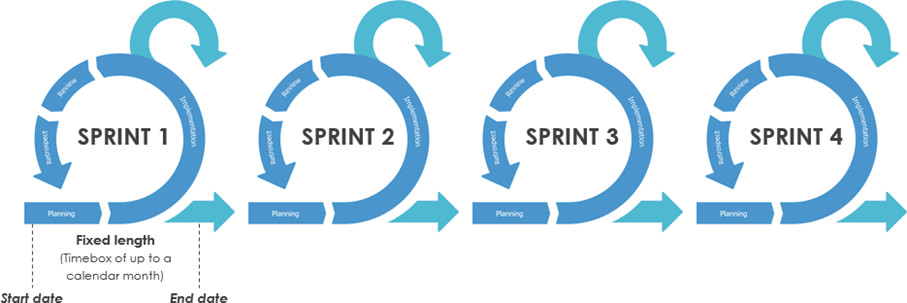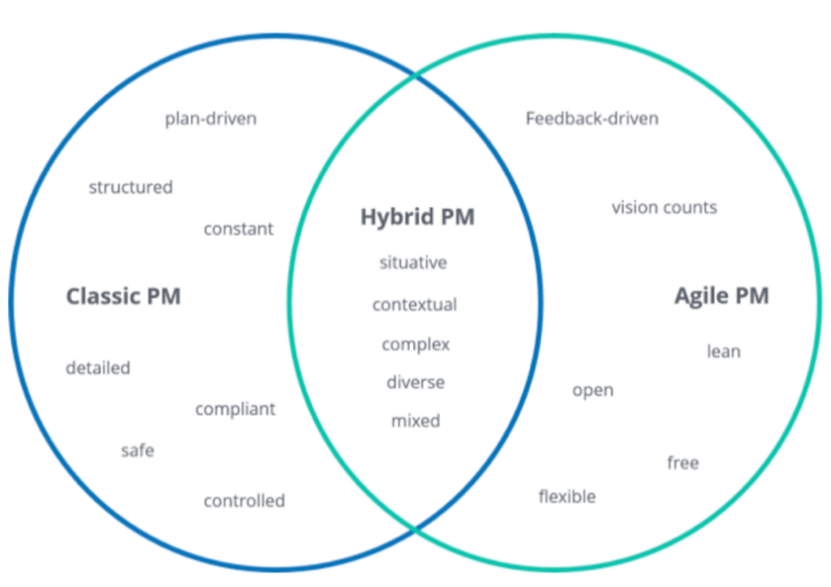
Exploring the suitability of hybrid project management for SAP implementations
Nowadays, it is often assumed that agile project management (PM) is the right approach to manage large-scale finance transformation projects. However, there are certain projects where the waterfall model may be more appropriate, such as projects with predictable requirements and a clear line from requirements to completion. For projects that extend over a longer time, it can be beneficial to switch to the hybrid project-management variant, which combines the best of the agile and waterfall methodologies. The advantages of the hybrid approach are that project management can respond more easily to requirements and needs. This helps, when implementing or upgrading complex SAP systems. In addition, hybrid PM allows more efficient management for project budgets as it can be tailored to the specific needs of a project, hence unnecessary spending can be avoided.
Examining the continued relevance of the waterfall model in project management
The waterfall model involves completing various phases in a project’s development process in a linear and sequential order. The first stage involves analyzing project specifications, followed by creating a design and testing the finished product to ensure compliance with requirements. The final phase includes deployment and maintenance to ensure ongoing product performance. Each phase’s tasks are completed before moving on to the next.
The project’s development can be monitored and managed more easily, but there may be less flexibility and customer involvement, less collaboration and transparency, and a longer time to GoLive as a result.
It is important to note that these phases are not always strictly separated and there may be overlaps or parallel work. The advantage is that the model can provide better control over the project budget and timeline. However, the waterfall model contains some limitations. The model’s key shortcomings are its lack of adaptability to changing conditions and requirements due to its linear, sequential procedure, and its limited client involvement, hindering communication and feedback between team members and stakeholders. This results in a lack of transparency and makes it challenging to address problems early, potentially leading to higher costs for adjustments later in the project.
Navigating challenges of agile project management in extended projects
Agile PM is a methodology that emphasizes adaptability, flexibility, and teamwork. Scrum, one of the most popular agile methodologies, is known for its flexibility and customer value. It encourages communication, teamwork, and uses an iterative process to improve the product. Daily stand-ups and impediment talks enhance communication and early problem identification and resolution. Agile PM emphasizes adaptability, flexibility, teamwork and uses sprints, short periods of time for completing and testing a limited amount of work. It ensures transparency in the project’s status and team objectives. Each sprint has a defined beginning and end and usually lasts between two to six weeks.

Agile project management has some drawbacks, such as the risk of taking shortcuts in the planning process, which could lead to increased costs or project delays.. The emphasis on quick, incremental deliverables in agile project management can also make it challenging to estimate the time and resources required for the entire project. Agile may not always be suitable for large-scale, complex projects that require intensive collaboration and planning among multiple teams. Effective team collaboration and communication is crucial in agile project management and can be difficult for virtual or geographically dispersed teams.
Efficient project management with the hybrid approach: combining agility and structure
It is possible to leverage on many of the advantages by using a hybrid approach including both alternatives. The hybrid PM approach is a combination of classic waterfall methods and agile project management methods.
It begins with high-level, top-down planning, where the phases of the project are laid out as waves of the waterfall model. These waves have corresponding quality control points. Within these waves, the individual tasks are iteratively panned using agile methods. This enables an overview of the project as well as flexibility and adaptability in the implementation. By using sprints, the project team can react flexibly to changes and adapt actions without jeopardizing the entire project. Content planning is iteratively done before the start of each wave and detailed before each sprint.

This approach provides both the necessary flexibility in the implementation of the actions (e.g. in terms of prioritisation and resource availability) and a high degree of customer focus, as there is a catalogue of requirements for each action that is implemented in stages. The agile implementation process supports sustainable development (PDCA) and promotes knowledge management between all stakeholders through close collaboration.

Improving efficiency with hybrid project management for SAP S/4HANA
Hybrid PM can be a suitable approach for SAP-implementation and Finance Transformation projects due to its flexibility in combining the benefits of both agile and traditional project management methods. This allows for a faster response to changes and greater planning accuracy, which can be particularly helpful in SAP projects where unforeseen changes may occur. The Waterfall Model is useful for shorter and well-defined projects as it provides a predictable and structured approach that allows project progress to be accurately planned and monitored.
Agile PM is particularly suitable for new and unclear projects where it is difficult to define the requirements in advance. Thanks to the iterative approach, the project can be continuously improved in small steps.
In hybrid PM, the testing process is tightly integrated into the development process. This means that tests are carried out regularly to identify and fix problems at an early stage. By using agile methodologies, the testing process is performed more frequently to get feedback from users and customers to ensure that the solution meets their needs. Therefore, hybrid PM focuses on the customer, allowing an incremental implementation of requirements. This is important for finance departments which use SAP solutions for financial management and accounting. The use of quality control points using Lean methods and tools based on Six Sigma and Toyota Way, ensures that high quality standards are maintained.
Summarizing the benefits of hybrid project management for SAP implementations.
Hybrid PM is a combination of waterfall and agile methodologies that offers a balance of structure and flexibility. It allows for top-down planning with phases defined as waves, while still allowing for individual tasks to be planned agilely. This approach offers benefits such as flexibility, customer focus, sustainable development, and quality control. It is suitable for SAP-related projects as it combines the advantages of both traditional and agile methods.
Draxinger & Lentz has many years of cross-industry experience in controlling and financial applications in SAP and has successfully completed numerous projects. For further information on SAP ECC or S/4HANA and especially their controlling and financial applications, please contact Andy Draxinger (andy.draxinger@www.draxingerlentz.de).